Abstract
Accelerating the development of agricultural aviation technology is the need of China’s modern agricultural construction. With the rise of emerging industries such as artificial intelligence, biotechnology, autonomous navigation, and the Internet of Things, agricultural aviation is further developing toward the direction of intelligence to meet the requirements of efficient and sophisticated agricultural aviation operations. Bionics is a multi-discipline and comprehensive border subject. It is produced by the mutual penetration and integration of life science and engineering science. Bionic technology has received more and more attention in recent years, and breakthroughs have been made in the fields of biomedicine and health, military, brain science and brain-like navigation, and advanced manufacturing. This study summarized the research progress of biomimetic technology in the field of agricultural aviation from three aspects of biological perception, biological behavior, and biological intelligence. On this basis, problems of related research and application of agricultural aircraft in real-time obstacle avoidance, path planning, and intelligent navigation were analyzed. Combined with the practice of the rapid development of agricultural aircraft, research and application of bionic technology suitable for agricultural aircraft were then proposed. Finally, prospects of agricultural aero-bionic technology were also discussed from multiple bionic target fusion, three-dimensional spatial information exploration, sensors, and animal brain system mechanism. This review provides a reference for the development of bionic technology in China’s agricultural aviation.
1. Introduction
Agricultural aviation refers to the aviation industry that serves agricultural production, including agricultural aircraft technology, remote sensing monitoring technology and equipment, aviation operation technology and equipment, etc. [1] It has the characteristics of high efficiency, uniform application, and wide adaptability [2]. Agricultural aviation is widely used in agriculture, forestry, fishery, animal husbandry, and other fields. It is an important development direction in China’s construction of efficient and reliable modern agriculture [3]. At present, with the development and application of emerging technologies such as artificial intelligence, autonomous navigation, biotechnology, Internet of Things, big data, smart equipment manufacturing, and 5G in various fields, agricultural aviation is moving towards intelligence [4,5]. As one of the new technologies that are of great significance to the development of emerging industries in the future [6], bionic technology provides new ideas for the intelligent development of agricultural aviation. Bionic sensing technology can realize the precise operation and real-time obstacle avoidance of agricultural aircraft, which is one of the important directions for the development of intelligent agricultural aviation in the future [7]. Bionic intelligent technology can complete autonomous learning and intelligent decision-making, realize autonomous navigation of agricultural aircraft, and improve operational efficiency [8]. The intelligent bionic algorithm can improve the operational path optimization and multi-aircraft cooperative operation of agricultural aircraft, which is the development trend of mobile robot path planning in the future [9].
Bionics, founded in 1960, is a science that studies biological systems, structures, traits, and working mechanisms. At present, bionic technology has penetrated into almost every field, and scholars from all over the world have carried out related research on bionics and made breakthrough progress. A lightweight and high-strength aircraft [10] was developed by imitating the truss structure of insect wings [11] and the dumbbell-shaped structure of animal bones [12]. Inspired by the sensitivity of cellulose to humidity, the spider egg sac silk was used to develop a humidity sensor with high sensitivity, heat resistance, and repeatability [13]. Through the research of the elephant nose and octopus hand, a flexible robotic arm has been developed, which has the characteristics of strong flexibility and adaptability to complex environments. The combination of bionic technology and agricultural aviation can achieve precise control of aviation aircraft, enabling it to have functions such as intelligent navigation and fine pesticide application, which is of positive significance to the development of precision agricultural aviation.
At present, some Chinese scholars have carried out related research on the intelligent agricultural aviation, but they have not systematically realized that this is aero-bionic, a combination of bionic technology and agricultural aviation. This review sorts out the research history of bionic technology in agricultural aviation in China from the aspects of biological perception, biological behavior, and artificial intelligence, then analyzes the current development of bionic technology in the field of agricultural aviation, and finally discusses the existing problems and future development prospects of agriculture aero-bionic technology in China.
2. Biological Perception and Agricultural Aviation
Agricultural aviation aircraft need to collect information about the surrounding environment in the process of operation, and high-precision and high-reliability sensors are the main means of environmental perception and data acquisition for agricultural aircrafts [14]. Facing the complex and harsh farmland operating environment, how to ensure the efficient and accurate information acquisition of aircraft is an urgent problem for researchers. After hundreds of millions of years of development, the sensing system of organisms can cope with the complex and changeable natural environment, providing ideas for the research of agricultural aviation sensors. At present, relevant Chinese scholars have put forward optimization schemes for how to improve the accuracy and reliability of sensor information acquisition by studying the mechanism of biological system perception. This section introduces the research progress of biological perception in China agricultural aviation through three aspects: echolocation and obstacle avoidance, binocular stereo vision, and compound eyes.
2.1. Echolocation and Obstacle Avoidance
In 1944, Griffin [15] successfully recorded the ultrasound emitted by bats, and named the process of acquiring information about the surrounding environment by bats emitting ultrasound as echolocation. At present, related studies have found that in addition to bats, the rodents of the genus Typhlomys [16], toothed whales [17], and birds [18] all have echolocation capability. Bat echolocation has multiple functions, such as target detection, information exchange, and environment recognition [19]. Accurate target information can be obtained by adjusting the frequency, intensity, and sound rate of echolocation sound waves. Ultrasonic detection has the characteristics of high resolution, strong directionality, wide application range, and large coverage area in short-range distance measurement [20]. It can detect harsh environments such as dark environment, electromagnetic interference, smoke, etc. [21], but temperature, humidity, gas density, etc., will affect the ultrasonic propagation speed [22], and the sound waves will gradually turn into heat during the propagation process, causing excess attenuation [23], so the accuracy of detecting long-distance targets is poor.
The development of ultrasonic sensor technology is relatively mature, and it is mainly used for ultrasonic detection and obstacle avoidance in agricultural aviation. At present, the research of ultrasonic detection technology is mainly focused on improving the accuracy and robustness of ultrasonic detectors. Zhang [24] proposed a segmented fitting algorithm, which combines the MCU main control chip, ultrasonic radar, collision warning, and other modules to form a collision avoidance warning system, which calculates the control function of each flight distance separately, and finally, summarized the optimal route to realize the safe flight of the aircraft. Zhang [25] proposed an idea to process the data obtained by the ultrasonic sensor and binocular vision through the Federal Kalman filter fusion algorithm to process and fuse the image information taken by the ultrasonic binocular, so as to improve the obstacle avoidance perception accuracy of UAVs (unmanned aerial vehicles). Aiming at the fact that multi-channel ultrasonic sensors occupy a lot of system hardware resources and control system software resources in robot obstacle avoidance, Zheng [26] and others developed the RS485 bus to expand multiple ultrasonic ranging slave stations, which improves the reliability of data communication and high-speed long-distance transmission performance, and saves the hardware and software resources of the robot control system.
Ultrasonic sensors are low in cost, small in size, and simple in structure [27]. They are widely used in obstacle avoidance and detection of plant protection UAVs, and are usually used in fixed altitude flights and the down-looking system of agricultural UAVs [28]. Since ultrasound’s accuracy will be affected due to complex environmental obstacles, air temperature, humidity, etc., it cannot be used alone. Therefore, fusing it with multiple sensors is a future research trend [29].
2.2. Binocular Stereo Vision Bionics
Marr [30], from the Massachusetts Institute of Technology, first proposed a visual computing theory, which uses two or more cameras with different angles to acquire image feature points and draw three-dimensional images. The geometric principle of binocular stereo vision is shown in Figure 1.
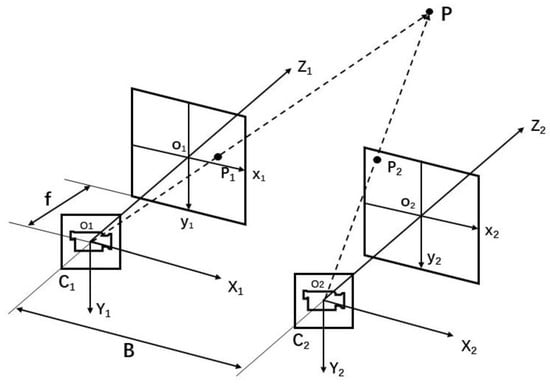
Figure 1.
Geometric principle of the binocular stereo vision system.
In Figure 1, C1 and C2 are two cameras with optical axes parallel to each other, and P1 and P2 are the imaging points of three-dimensional space point P on two two-dimensional imaging planes, x1o1y1 and x2o2y2, respectively. The relationship between depth and parallax is as follows:
where Z is the depth, B is the baseline, d is the difference between p1 and p2 in the x-axis direction, and f is the focal length.
Binocular stereo vision technology has the advantages of fast speed measurement at short-range, high accuracy, and no contact [31], but the accuracy is reduced during long-distance detection, and it is difficult to match the object image with low texture [32]. In practical application, camera parameter setting, illumination change, environmental change, equipment performance, etc., will cause differences in image-matching results and affect target detection accuracy [33].
At present, the research on binocular vision systems mainly focuses on the stereo matching algorithm. Liu [34] proposed an improved adaptive weighting algorithm to solve the problems of occlusion and depth discontinuity in binocular matching, which greatly reduced the influence of the depth discontinuity area, optimized the parallax map, and improved the accuracy of generating the parallax map. Wang [35] proposed an autonomous path planning algorithm of plant protection UAV combined with GNSS (Global Navigation Satellite System, Xianyang, China ) and binocular vision to solve the problem that plant protection UAV cannot accurately spray in mountain fruit tree planting. First, GNSS navigates the UAV to the operation area, and then the yaw angle of the UAV is adjusted by the binocular vision sensor to complete the precision operation of the UAV. Zhu [36] aimed at improving the efficiency and accuracy of obstacle avoidance during UAV flight, and proposed a method of combining binocular stereo vision and optical flow. The distance of obstacles is obtained through binocular stereo vision, and the instantaneous speed of obstacles to cameras is calculated by the SIFT (scale-invariant feature transform) optical flow method to create the obstacle avoidance strategy. The combined algorithm has significantly improved the calculation speed and obstacle avoidance effect.
In recent years, binocular stereo vision technology has developed rapidly, and the research hotspots mainly focus on the stereo matching algorithm. The future development will also focus on optimizing the calculation speed of the algorithm, researching more comprehensive visual computing theories and matching strategies [37], and fusion of multiple algorithms, etc. Binocular stereo vision is widely used in agricultural aviation, especially plant protection UAVs. For example, the industrial-grade UAV, MATRICE M300 RTK (DJI Innovation Technology Co., Ltd., Shenzhen, China), introduced binocular vision and infrared perception sensors into the six faces of the fuselage at the same time, for the first time. Its sensing system is shown in Figure 2. The system has the characteristics of omni-directional six-way sensing, accurate positioning, fast obstacle avoidance, etc. In addition, Mavic2, Inspire2, and the phantom series of DJI UAVs are equipped with binocular vision systems and infrared sensors in different positions of the fuselage. The plant protection UAV CD-15 (Hanhe Aviation Technology Co., Ltd., Wuxi, China) uses a binocular vision system and a laser detection system to mix and match. The P series plant protection UAVs (the XAG Technology Co., Ltd., Guangzhou, China) is equipped with the Xcope eye vision module, which can perceive objects within 30 m [38], and can effectively avoid obstacles in real time.
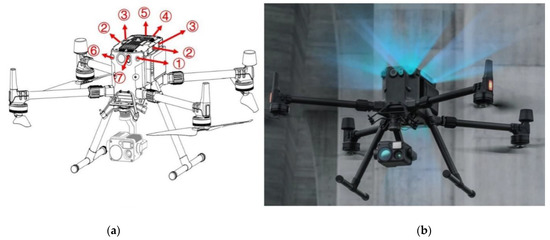
Figure 2.
MATRICE M300 RTK six-way sensing system: (a) function annotation, and (b) product in kind [39]. Note: ① front vision system, ② left vision and right vision infrared perception system, ③ left vision and right vision system, ④ top vision system, ⑤ top vision infrared perception system, ⑥ FPV camera, and ⑦ front vision infrared perception system.
2.3. Compound Eye Bionics
In 1826, Miller [40] proposed the Mosaic theory of compound eye. By the middle and late 20th century, as researchers from various countries began to explore the theory and experiment of compound eyes, people’s understanding of compound eyes gradually shifted from a biological perspective to an optical perspective. The compound eyes of insects are composed of thousands of sub-eyes, and each sub-eye has an independent optical system, which is finally spliced to obtain a large field-of-view image. A bionic compound eye can obtain the space, position, speed, and other information of the target object by imitating the mechanism of the insect compound eye, so as to achieve the purpose of image acquisition, spatial positioning, and fast obstacle avoidance of the target object. It has the advantages of high sensitivity, fast information acquisition, high time resolution, and large field-of-view [41].
In recent years, the bionic application and research of compound eyes has mainly focused on two aspects: curved array and camera array. However, because the existing curved surface technology is not perfect, the research on curved compound eyes is still in the theoretical stage. Chen [42] used 7 CCD cameras to simulate the compound eyes of flies and designed a bionic compound eye vision system to improve real-time and high-quality image mosaic requirements, which effectively solved the problem of mosaic image misalignment and enhanced the real-time performance of the system. However, this method requires high alignment accuracy of two adjacent sub-images, which is the focus of improvement in the future. Pang [43] imitated the structural characteristics of biological compound eyes and arranged 16 CCD sensors into a curved surface to realize image acquisition without blind spots in the 180 × 75° field-of-view, and to improve the resolution. Aiming at the shortcomings of small drone-borne cameras, such as small field-of-view and narrow imaging range, Yu [44] designed a small size, field angle of up to 106°, micro-miniature bionic compound eye camera. The curved arrangement of the small lens array, optical transformation subsystem, and the data processing unit is composed of three parts. The lens arrangement is shown in Figure 3. In order to increase the overlap rate of the potential fields of adjacent lenses, the lens array in the center A area adopts a regular pentagonal arrangement. The rest of the area is arranged in a hexagonal shape, and the system can collect a target of 0.5 m on the ground at a height of 500 m to achieve a large field-of-view and a high-resolution imaging effect.
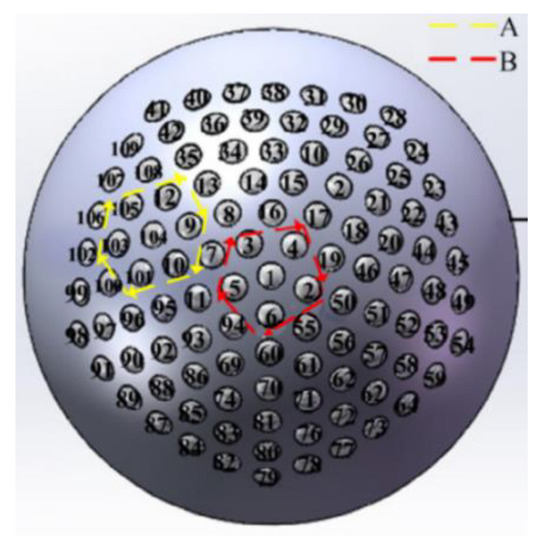
Figure 3.
Structure of curved compound eye camera [44]: regular pentagonal arrangement (A) and regular hexagonal arrangement (B).
The bionic compound eye sensor has the characteristics of high sensitivity, compact structure, large field-of-view, and high resolution. It has broad application prospects in the fields of aviation, detection, robot vision, target recognition, and tracking. Due to the slow progress in optical micro-processing technology, equipment debugging, image acquisition, splicing, etc., in the application of agricultural aviation, the accuracy of the bionic compound eye sensor is easily affected by factors such as harsh environments, and there are still many deficiencies to be improved. The application development in agricultural aviation is still in its infancy. The future development of compound eye bionic technology in agricultural aviation will include fast-precision measurement, real-time obstacle avoidance, a bionic compound eye manufacturing system, and micro-integration.
The list of relevant research on bionic technology mentioned above is compared and analyzed, as shown in Table 1. The characteristics of various bionic technologies, as well as the research hotspots in the field of agricultural aviation, are summarized.

Table 1.
Characteristics of bionic technologies and research hotspots in agricultural aviation.
3. Biological Behavior and Agricultural Aviation
During the operation process, the UAV will complete the task according to the artificially planned route. However, in actual operation, due to the influence of external factors such as obstacles, environment, flight conditions, etc., the UAV route will deviate and even cause air accidents, affect the operation efficiency, and increase the operation cost. Path planning of UAV means that UAV optimizes the route during operation, and finds an optimal collision-free path according to specific performance settings, such as optimization time, distance, and energy consumption, so as to improve efficiency and complete operation tasks. In recent years, inspired by the behavior of biological groups, people have proposed a series of intelligent bionic algorithms for optimizing paths and have achieved remarkable results by studying some behavior characteristics of biological groups, such as the ant colony algorithm, fish swarm algorithm, particle swarm algorithm, etc. [45].
3.1. Ant Colony Optimization
Dorigo et al. [46] first discovered and proposed ant colony optimization. Ants have no vision, but they can find the optimal path. This is because ants release a pheromone along the path they walk, and move towards the path with high concentration according to the pheromone concentration on the way to find the optimal path. The process of ants searching for food is shown in Figure 4. The ant colony algorithm is a bionic algorithm proposed through the collective path-finding behavior of ants, and the algorithm mainly includes probability criteria and a pheromone update mechanism. In the algorithm, the ants will judge the probability of going to the next node based on the values of the initial pheromone and heuristic information. After all ants have completed a traversal, the pheromone concentration on the path will be updated. They repeat the above steps until the optimal path is found. The flow chart of the ant colony algorithm is shown in Figure 5. The ant colony algorithm can quickly find the local optimal solution. Compared with other algorithms, it has better time performance [47], search stability, and high accuracy [48]. However, there is random probability and poor pheromone interference in the operation of the algorithm, which will lead to the low quality of the solution [49], and the algorithm has problems such as insufficient initial information, slow convergence speed, and ease of falling into local optimal solutions [50].
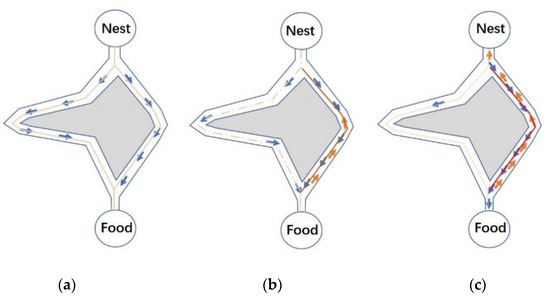
Figure 4.
Ant foraging process: (a) early path search, (b) mid-route search, and (c) optimal path.
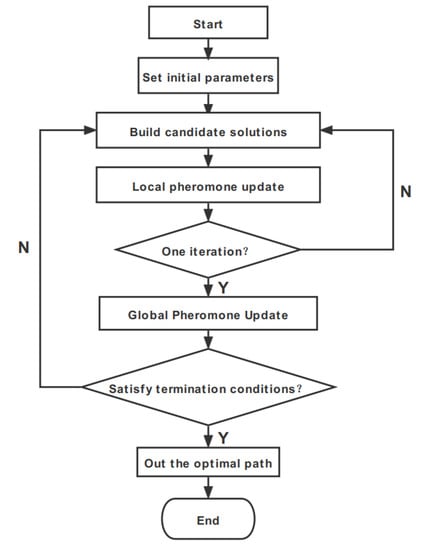
Figure 5.
Flow chart of the ant colony algorithm.
Agricultural aviation, especially plant protection UAVs, must face a complex operating environment during the operation. The application of the ant colony algorithm can effectively improve the efficiency of UAVs. Considering the limitations of the ant colony algorithm, it is usually combined with other algorithms to improve the convergence speed of the algorithm and reduce the likelihood of falling into a local optimal solution. Wang [51] proposed an improved ant colony algorithm for the operation area of plant protection UAVs with irregular polygons and internal obstacles, discretized the plane operation path to generate a three-dimensional path, and then reasonably planned the path points in the path. The experimental results show that the optimization path of the algorithm is significantly improved compared with the greedy algorithm and has certain practicability. Wang [52] analyzed the ant colony algorithm through grid environment modeling, and proposed an ant colony opposite search strategy and ant backtracking strategy to improve the search efficiency of the algorithm, while avoiding the algorithm from falling into a U-shaped trap, and redefining the pheromone. The experimental results show that compared with the traditional ant colony algorithm, the improved ant colony algorithm has a faster convergence speed and an optimal path. Feng [53] proposed an intelligent combination algorithm combining the A* algorithm and ant colony algorithm for complex low-altitude environments. The combination algorithm adds the A* algorithm to overcome the problems of slow convergence and falling into a local optimal solution of the ant colony algorithm. The global optimal path is found through the A* algorithm, and then the local optimal path is planned in combination with the ant colony algorithm. The experimental results show that the combined algorithm can not only improve the speed of path optimization, but also avoid obstacles.
The ant colony algorithm was originally proposed to solve the traveling salesman problem. With the development of science and technology, it has been gradually applied to optimization problems in various fields. In the spraying operation of plant protection UAVs, the application of the ant colony algorithm can effectively reduce energy consumption costs, improve efficiency, and help to promote the development of precision agricultural aviation.
3.2. Particle Swarm Optimization
Particle swarm optimization (PSO) is an intelligent algorithm proposed to study the predation behavior of birds [54]. Birds search for food through cooperation among individuals. Each individual is regarded as a particle, with only position and velocity information. The particles follow the optimal particle to search in space. The particle swarm optimization algorithm first sets up the initial particle swarm and searches for the optimal solution through traversal. In each iteration, the particle will update its position and speed through the individual extreme value, Pbest, and the global extreme value, Gbest, and adjust its fitness value to find the optimal solution [55]. The process is shown in Figure 6.
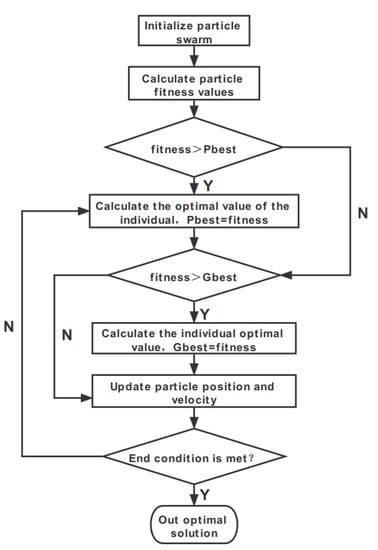
Figure 6.
Flow chart of particle swarm optimization.
The particle swarm algorithm has the advantages of being a concise algorithm, easy implementation, good robustness, and fast convergence speed [56], but it is easy to fall into the local optimal solution and has a great impact on the search results [57]. In view of the problems of slow convergence of later calculations and the ease of falling into local optimal solutions when the particle swarm optimization is applied to the multi-aircraft cooperative task assignment of UAVs, Wu [58] proposed a hybrid PSO-BAS (particle swarm optimization-beetle antennae search) algorithm, in which the beetle antennae search algorithm originated from the foraging behavior of beetles. Beetles sense the intensity of food odors in the air through a pair of antennae on the top of their heads, and fly in the direction of the strong odor concentration. The beetle antennae search algorithm regards the food odor as a function. According to the difference of the value of the function in the three-dimensional space, the beetle explores the odor values of two points in the surrounding environment through two whiskers, until the optimal value is found. It combines the advantages of fast local convergence of the beetle antennae search algorithm with the particle swarm optimization algorithm to solve the problem of easily falling into a local optimal solution. The convergence speed of the algorithm is accelerated by adjusting the particle swarm inertia weight. The experimental results prove that the algorithm solves the multi-machine task allocation problem with fast convergence speed and high accuracy. Han [59] aimed at the slow convergence speed of traditional planning in complex environments and the tendency to fall into local optimal solutions. They proposed a repulsive field–particle swarm fusion algorithm to perform raster processing on obstacles in complex environments. The obstacle repulsion potential field constructs a function to adjust the particle position and velocity to calculate the optimal path. The experimental results verify that the improved fusion algorithm is capable of obtaining the optimal solution of the optimization path with a faster convergence speed. Fang [60] proposed a strategy combining inertia weight adjustment and jumping out of the local optimal solution for the optimization and real-time of UAV trajectory planning. This strategy can reduce the search space and improve the optimization accuracy and stability of the algorithm. The experimental results show that it is possible to generate more trajectories while satisfying online real-time trajectory planning.
As a new intelligent bionic algorithm, particle swarm optimization has been widely used in engineering technology, scientific research, and other fields [61]. Compared with traditional algorithms, particle swarm optimization provides new ideas to solve the path planning problem in the complex environment of agricultural aviation.
3.3. Genetic Algorithm
The genetic algorithm is a global optimization intelligent algorithm, which is inspired by Darwin’s evolution theory. Based on the mechanism of natural genetics and natural selection, it uses crossover, mutation, and selection to simulate the process of biological evolution. The core steps in the algorithm mainly include coding, initialization, selection, crossover, and mutation. Firstly, the solution problem is coded and transformed into the solution space of the genetic algorithm. Each code is a feasible solution to form an initial population. Secondly, the individual is evaluated according to the principle of survival of the fittest. Their individual fitness is calculated, and finally, high-quality individuals are selected for cross-mutation to generate a new generation of high-quality solution populations, and the above steps are repeated until the optimal solution is generated [62]. The flow of genetic algorithm operation is shown in Figure 7. The genetic algorithm is a multi-point search algorithm, which can calculate and optimize complex multi-objectives at the same time, avoid falling into local minimum points, and ensure the global optimization ability [63]. The genetic algorithm has fast calculation in the early stage, but large amounts of redundant iterations in the later stage, which is not suitable for real-time trajectory planning [64].
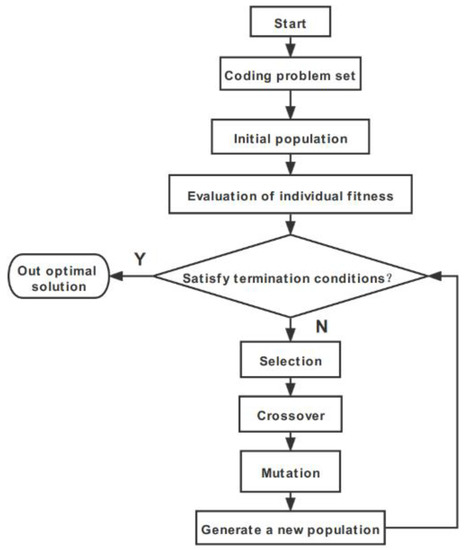
Figure 7.
Flow chart of the genetic algorithm.
At present, many scholars have put forward improvement strategies to solve the problems of slow convergence speed and the ease of falling into local optimization in the later stage of the genetic algorithm. Cheng [65] proposed an improved genetic algorithm, the simulated annealing algorithm, which does not easily fall into the local optimal solution. This feature is integrated into the genetic algorithm to better solve the local optimal problem, and the directional mutation is introduced to speed up the search speed of the optimal solution of the genetic algorithm. Huang [66] improved the three operators of selection, crossover, and mutation in the genetic algorithm. Aiming at the premature convergence of the algorithm, a hybrid non-multiple string selection operator was proposed. In order to improve the convergence effect of the algorithm, an asymmetric mapping crossover operator was proposed. Through the heuristic multiple mutation operator, the premature phenomenon of the algorithm is suppressed. The results show that the improved algorithm has good environmental adaptability. Xu [67] proposed a global planning algorithm for plant protection UAVs for multi-regional operations of plant protection UAVs. The algorithm is divided into three parts: single-region route planning, inter-regional operation sequence planning, and inter-regional route scheduling planning. The improved genetics algorithm mainly focuses on the regional operation sequence and inter-regional route planning. The optimal operation area sequence is first solved, and then the optimal inter-area scheduling route is obtained through the improved genetic algorithm. The results show that the algorithm effectively realizes the global planning and improves the operational efficiency of plant protection UAVs.
At present, the research hotspots of the genetic algorithm mainly focus on the improvement of the algorithm. Based on the characteristics of the genetic algorithm being suitable for global search and strong robustness, it can be better applied to agricultural aviation operations in complex environments, and the algorithm is easy to combine with other algorithms [68], which can provide a more suitable fusion algorithm for different plant protection operation requirements.
4. Biological Intelligence and Agricultural Aviation
4.1. Brain-Like Navigation
Brain-like navigation has received extensive attention in recent years and has become one of the research hotspots in the field of artificial intelligence. In 1984, Tolman proposed that animals understand the environment through “cognitive maps” [69], and scholars have begun to explore animal brain navigation. In 1971, O’Keefe found place cells in the hippocampus of rats, then head direction cells, grid cells, border cells, etc., were discovered one after another. The mammalian brain has its own intelligent navigation system, which can form a cognitive map for positioning and navigation of the surrounding environment. This is related to the cells in the brain. The navigational cells mainly include head direction cells, grid cells, place cells, and border cells [70]. Head direction cells are responsible for recognizing the animal’s position in the environment, and act as a compass in animal navigation. Grid cells and place cells cooperate to draw a cognitive map. Cells of the brain-like navigation system work together to continuously update the error-correcting cognitive map for precision navigation. The schematic diagram of the mammalian brain navigation system is shown in Figure 8.
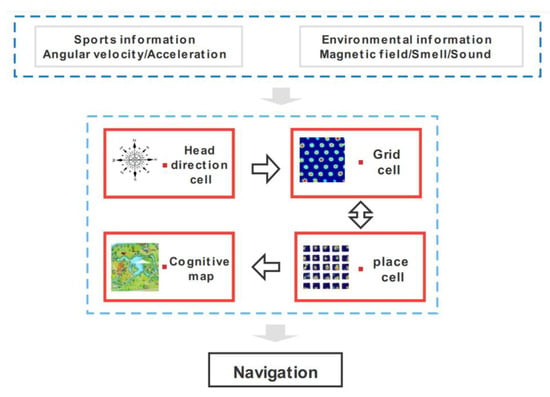
Figure 8.
Schematic diagram of the mammalian brain navigation system.
Since humans have not yet fully understood the mechanism of the mammalian brain, the current development of brain-like navigation technology is at the stage of theoretical research. Liu [70] analyzed the key technology of the neural dynamics model combined with the neural network and attractor dynamics for navigation. This technology does not require modeling, does not require high sensor accuracy, is suitable for a variety of complex environments, and is robust. It has a strong development prospect. Liu pointed out that how to simulate the brain navigation mechanism from a deeper level, and how to improve the efficiency, accuracy, and real-time capabilities of the brain-like navigation model are the focuses for future research. Han [71] proposed a grid cell construction model based on differential Hebbian learning. This model builds the input correlation between grid cells and the Mexico model by learning the change value of the positional cell discharge rate. This model provides a reference for the construction of UAVs’ brain-like navigation system. Chen [72] used a one-dimensional ring attractor to model the head-facing cells, and used the sinusoidal interference model to obtain the grid-like activity pattern, and finally obtained the optimal movement direction according to all the activity sets, which solved the problem of dynamic adjustment of the network. It is effective and reliable, with superior navigation performance.
Although brain-like navigation technology is the current hotspot of artificial intelligence, in-depth research on the brain and neurons is still needed. Brain-like navigation can realize unsupervised and autonomous operation of plant protection UAVs, abandon the unreliability of GPS (Global Positioning System) navigation due to signal fluctuations, and can autonomously respond to complex unknown environments such as light, rain, snow, and low visibility, so as to achieve precision agricultural aviation. At present, the research of brain-like navigation is not perfect, and the problems of large environment storage and calculation, and poor stability caused by imperfect algorithms still need to be solved.
4.2. Convolutional Neural Network
An artificial neural network is a kind of simulated bionics of biological neural networks. It is a dynamic network system composed of a large number of nonlinear arrangements of neurons. A convolutional neural network is an artificial neural network that includes convolutional layers, and is usually used to identify two-dimensional images [73], has stronger learning and expression capabilities than traditional machine learning [74], and can simulate the human visual system to classify feature data by extracting target images to achieve target recognition [75]. At present, convolutional neural networks have achieved certain results in the fields of artificial handwriting recognition [76], face detection [77], crop recognition [78], terrain perception [79], and other fields, and they have attracted the attention of many agricultural researchers [80]. Zhang [81] proposed to use the Series Otsu method, Faster Regional Convolutional Neural Network, and YOLO-v3 methods to identify the flowering state of rice, and also use the open and inner glumes. Experimental results show that the combination of the Series Otsu method and the Faster Regional Convolutional Neural Network to identify the flowering state of rice has a high degree of consistency with manual observation, and it can be used instead of the artificial use of a drone for rice flowering detection. In order to improve the accuracy of UAV image recognition, Zhen [82] proposed the CNN-PNN (convolutional neural network-probabilistic neural network) model, which is a hybrid model combining the convolutional neural network and probabilistic neural network. The convolutional neural network is used to extract sample images. The feature vector is trained by a probabilistic neural network model and the output result. The simulation result shows that the model’s recognition rate is as high as 96.3%. Liu [83] proposed a method of a fully convolutional neural network to identify pest areas, using a multi-rotor UAV to acquire pest images from the air, marking the pixels of the pest areas, learning and training, and constructing a model to identify the pest areas. Experiments show that the method has high recognition accuracy, and the pixel accuracy rate is as high as 97.86%. In order to improve the accuracy of pest identification, Yang [84] proposed a deep learning model of the convolutional neural network, which used image saliency analysis and the Grubcut algorithm to locate pests in complex backgrounds, and expressed and classified tea garden pests through the Alexnet convolution neural network architecture, so as to avoid human subjective factors affecting the classification results. Ma [85] built a greenhouse cucumber disease recognition model based on the convolutional neural network through the combination of deep learning and image processing technology. According to the characteristics of mixed colors, the model was compared with traditional colors, and the model was trained through image data collection and calculation. The results show that the accuracy of the model is up to 95.7%.
5. Discussion
This review summarized the application principles of bionics from the three modules of biological perception, biological behavior, and biological intelligence, and analyzed the latest progress of bionic technology in China’s agricultural aviation research by enumerating representative literature. From the perspective of the development of bionic technology in human history, the development of bionics has not been smooth sailing since its conception more than 60 years ago. In the development, due to the backwardness of biology, manufacturing technology and equipment, analysis and testing technology and instruments, many bionic research studies cannot be carried out. As can be seen from Figure 9, relevant research on bionics had been carried out before the birth of the word bionics. This development phenomenon of wave-like progress is also one of the main reasons why people do not systematically recognize the combination concept of aero-bionics.
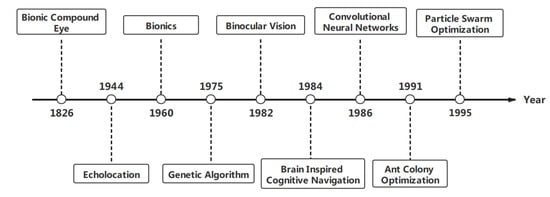
Figure 9.
The timeline of research on bionic technology.
In general, bionic technology provides a new direction for the development of agricultural aviation. The proposal and improvement of various intelligent bionic algorithms have enriched agricultural aircraft precision and autonomous operation capabilities. The development of bionic sensors also provides new technical approaches to solve the problems faced by agricultural aircraft in obstacle avoidance and data collection. Bionics is a multi-discipline and comprehensive border subject. It is produced by the mutual penetration and integration of life science and engineering science. Looking to the future, the research on agriculture aero-bionic technology requires breakthroughs in the following four aspects:
- Research on multiple bionic targets. In the complex and harsh farmland environment, aviation operations are usually faced with multiple complex problems. While a single bionic target provides an optimized solution to a specific problem, it also has limitations. Only by effectively realizing these goals can the optimal bionic design requirements be better achieved. For example, in the face of complex farmland operating environments in the future, a variety of combinations can be proposed for different sensor characteristics so that agricultural aircraft can cope with complex operating environments and achieve real-time obstacle avoidance requirements, and it can also provide feasibility for the realization of precision spraying and intelligent navigation for agricultural aircraft. A variety of fusion bionic algorithms can propose optimal solutions for farmland environments with different operating requirements, avoiding the problems of slow calculations and ease of falling into local optima in a single algorithm. At the same time, according to the different characteristics of each algorithm, a more optimized bionic fusion algorithm can be designed according to the types of farmland operation and existing problems in the future. Therefore, the fusion of multiple bionic designs will help to efficiently solve the technical problems faced in the field of agricultural aviation.
- In-depth exploration of three-dimensional spatial information. Three-dimensional spatial information exploration is mainly used in the fields of UAV obstacle avoidance, path planning, and image acquisition. When an aircraft faces complex and changeable operating environments such as terrain and air obstacles, the problem of how to effectively identify obstacles and make correct obstacle avoidance decisions still needs to be resolved. In China, there is relatively little research on the three-dimensional space operation of agricultural aircraft, and the follow-up work should increase the relevant research on the three-dimensional space operation of agricultural aviation.
- Research on miniaturization, integration, and intelligence of sensor devices. In the face of a harsh operating environment, the operational efficiency of agricultural aircraft is inseparable from the support of communication, navigation, command, and other sensor equipment in the aircraft. At present, in the Chinese agricultural aviation aircraft, sensor equipment can complete the work of information collection and communication of the operating environment. However, the function of the sensor is relatively single, and the product has a large gap with biological perception in terms of power consumption, volume, and anti-interference in a complex environment. Therefore, in the future, it is necessary to improve the equipment manufacturing process, combine with bionic technology, strengthen the development of miniaturized sensor devices, and conduct in-depth research on integrated and intelligent sensor devices.
- In-depth research on the mechanism of animal brain systems. Poor operating environment, electromagnetic interference, weak signal, and other factors usually affect the operating efficiency of agricultural aircraft, and even make it impossible to operate. Intelligent positioning and navigation technology obtains the surrounding environment information by imitating the mechanism of an animal brain system to construct cognitive maps or deep learning, so as to achieve the purpose of autonomous navigation and image recognition without relying on communication equipment. Agricultural aviation research on animal brain systems mainly focuses on deep learning, intelligent navigation, etc., but the current research is still at the theoretical stage, mainly because human beings have not yet fully understood the brain structure of animals, and the principle of cooperation between various cells and neurons in the brain needs to be further explored. In recent years, the combination of animal brain bionic research and robot learning has gradually become a new development trend, which provides a direction for the future intelligent development of agricultural aviation.
6. Conclusions
With the rapid development of science and technology, people’s understanding of bionics is becoming more and more profound. The application of bionic technology in agricultural aviation will show diversified development, and the distribution of its research content is also extremely wide. From macro to micro, part to whole, and function to structure, all the advantages of biological systems can be applied in agricultural aviation. The development of aero-bionics in the field of agricultural aviation is diverse, and the integration of current advanced research results with agricultural aviation technology will enable bionics to make breakthroughs in the field of agricultural aviation. The cross-integration of technology and artificial intelligence, nanotechnology, biological systems, digital technology, remote sensing technology, management technology, and other disciplines is of great significance for promoting the transformation of China’s agriculture from traditional agriculture to modern agriculture. The development of agricultural aviation is an indispensable force for the development of agricultural modernization. Therefore, learning the bionic concept and methods of simulating nature will strongly promote the development of precision agricultural aviation in China, and realize the agricultural aviation concept of high efficiency, green, low consumption, and sustainable development.
Author Contributions
Conceptualization, Y.Z. and Y.L.; methodology, H.T., Y.Z. and X.H.; validation, H.T. and L.W.; formal analysis, H.T., X.H. and C.M.; investigation, Y.Z., H.T. and L.W.; resources, H.T. and H.L.; data curation, H.T. and C.M.; writing—original draft preparation, H.T., C.M. and Y.Z.; writing—review and editing, Y.Z., X.H. and C.M.; visualization, H.T. and C.M.; supervision, Y.Z.; project administration, Y.Z. and Y.L.; funding acquisition, Y.L. All authors have read and agreed to the published version of the manuscript.
Funding
This research was funded by the Key Field Research and Development Plan of Guangdong Province, China, grant number 2019B020221001, the Science and Technology Plan Project of Guangdong Province, China, grant number 2018A050506073, and the 111 Project, grant number D18019.
Institutional Review Board Statement
Not applicable.
Informed Consent Statement
Not applicable.
Data Availability Statement
Not applicable.
Conflicts of Interest
The authors declare no conflict of interest.
References
- Zhou, Z.Y.; Ming, R.; He, X.G.; Luo, X.W.; Lan, Y.B. Development status and countermeasures of agricultural aviation in China. Trans. Chin. Soc. Agric. Eng. 2017, 33, 1–13. [Google Scholar]
- Qi, W.Z.; Wang, F.F.; Meng, Z.; Zhang, D.L.; Wang, H.Y.; Qiao, K.; Ji, X.X. Application status of unmanned aerial vehicle for plant protection in China. Agrochemicals 2018, 57, 247–254. [Google Scholar]
- Luo, X.W.; Liao, J.; Hu, L.; Zang, Y.; Zhou, Z.Y. Improving agricultural mechanization level to promote agricultural sustainable development. Trans. Chin. Soc. Agric. Eng. 2016, 32, 1–11. [Google Scholar]
- Luo, X.W.; Liao, J.; Hu, L.; Zhou, Z.Y.; Zhang, Z.G.; Zang, Y.; Wang, P.; He, J. Research progress of intelligent agricultural machinery and practice of unmanned farm in China. J. South China Agric. Univ. 2021, 43, 1–15. [Google Scholar]
- Zhao, C.J. Current situations and prospects of smart agriculture. J. South China Agric. Univ. 2021, 43, 1–10. [Google Scholar]
- Tao, Y.; Wang, T.M.; Liu, H.; Jiang, S. Insights and suggestions on the current situation and development trend of intelligent robots. Chin. High Technol. Lett. 2019, 29, 1–10. [Google Scholar]
- Lan, Y.B.; Wang, L.L.; Zhang, Y.L. Application and prospect on obstacle avoidance technology for agricultural UAV. Trans. Chin. Soc. Agric. Eng. 2018, 34, 104–113. [Google Scholar]
- Li, D.L.; Li, Z. System Analysis and development prospect of unmanned farming. Trans. Chin. Soc. Agric. Mach. 2020, 51, 1–12. [Google Scholar]
- Lin, S.J.; Dong, C.; Chen, M.Z.; Zhang, F.; Cheng, J.H. Summary of new group intelligent optimization algorithms. Comput. Eng. Appl. 2018, 54, 1–9. [Google Scholar]
- Guo, C.; Lu, Z.Y.; Wu, Y.Q. The application of biomimetic lightweight sandwich panel to the aircraft structure with large cutout and its optimum design. J. Mech. Eng. 2017, 53, 25–135. [Google Scholar] [CrossRef]
- Ma, Y.; Ma, T.B.; Ning, J.G.; Gorb, S. Structure and tensile properties of the forewing costal vein of the honeybee Apis mellifera. Soft Matter 2020, 16, 4057–4064. [Google Scholar] [CrossRef] [PubMed]
- Zhang, Z.H.; Zhang, G.K.; Tong, J.; Lai, Q.H.; Gao, X.H.; Tang, Y.; Stephen, C. Microstructure and tribology characteristics of head and chest exoskeleton of Procambarusclarkii. Trans. Chin. Soc. Agric. Eng. 2018, 34, 52–58. [Google Scholar]
- Guo, Y.Q.; Yu, L.Z.; Mou, J.Z.; Wu, D.H.; Zhou, P.J.; Xu, M.S. Mechanical properties and application analysis of spider silk bionic material. E-Polym. 2020, 20, 443–457. [Google Scholar] [CrossRef]
- Yin, Y. An Overview of smart sensors technology developing. Microelectronics 2018, 48, 504–507. [Google Scholar]
- Li, Y.P.; Yang, J.; Li, X.D.; Tian, J. Texture classification based on echolocation used by bat. Appl. Acoust. 2007, 26, 335–340. [Google Scholar]
- He, K.; Liu, Q.; Xu, D.M.; Qi, F.Y.; Bai, J.; He, S.W.; Chen, P.; Zhou, X.; Cai, W.Z.; Chen, Z.Z.; et al. Echolocation in soft-furred tree mice. Science 2021, 372, 1305. [Google Scholar] [CrossRef]
- Liu, Z.; Bai, Q.; Shi, P. Genetic and lutionary mechanisms of convergent phenotypes in animals. Sci. Sin. Vitae 2019, 49, 338–344. [Google Scholar] [CrossRef]
- Brinkløv, S.; Fenton, M.B.; Ratcliffe, J.M. Echolocation in oilbirds and swiftlets. Front. Physiol. 2013, 4, 123. [Google Scholar] [CrossRef]
- Li, C.R.; Luo, B.; Wang, M.; Feng, J. Research progress on the function of acoustic signals in bats. Sichuan J. Zool. 2018, 37, 710–720. [Google Scholar]
- Li, G.; Meng, X.J.; Wang, X.H.; Wang, C.Q. Research and application status on domestic ultrasonic ranging. Sci. Surv. Mapp. 2011, 36, 60–62. [Google Scholar]
- Ohya, A.; Ohno, T.; Yuta, S. Obstacle detectability of ultrasonic ranging system and sonar map understanding. Robot. Auton. Syst. 1996, 18, 251–257. [Google Scholar] [CrossRef][Green Version]
- Li, M.S. The principle and practical technology of ultrasonic distance measurement. China Meas. Test 1994, 01, 12–20. [Google Scholar]
- Su, W.; Gong, B.J.; Pan, X. Error analysis of measuring distance with ultrasonic. J. Transducer Technol. 2004, 23, 8–11. [Google Scholar]
- Zhang, Y.Y.; Zhang, Y.J. Design of civil aviation airborne collision avoidance early warning system based on piecewise fitting algorithms. J. Xi’an Polytech. Univ. 2019, 32, 218–224. [Google Scholar]
- Zhang, Y.H. Obstacle Avoidance Control System Design for Quadcopters Based on Machine Vision. Master’s Thesis, Nanjing University of Aeronautics and Astronautics, Nanjing, China, 2017. [Google Scholar]
- Zheng, K.; Hou, W.G.; Yao, Q.; Hua, Y. Multi-channel Ultrasonic Distance Measuring System of RS485 Bus Based on STM32 Microprocessor. Instrum. Tech. Sens. 2018, 425, 9–82. [Google Scholar]
- Liu, H. Research on Method of Altitude Measuring Based on Ultrasonic Ranging for SUAV. Master’s Thesis, Inner Mongolia University of Technology, Inner Mongolia, China, 2015. [Google Scholar]
- Wang, M. Localization and obstacle avoidance control of agricultural robot based on DSP and ultrasonic distance measurement. J. Agric. Mech. Res. 2017, 39, 207–211. [Google Scholar]
- He, Y.; Jiang, H.; Fang, H.; Wang, Y.; Liu, Y.F. Research progress of intelligent obstacle detection methods of vehicles and their application on agriculture. Trans. Chin. Soc. Agric. Eng. 2018, 34, 21–32. [Google Scholar]
- Bai, M.; Zhuang, Y.; Wang, W. Progress in binocular stereo matching algorithms. Control Decis. 2008, 23, 721–729. [Google Scholar]
- Sun, J.H.; Zhang, G.J.; Wei, Z.Z.; Zhou, F.Q. Mobile 3D vision measurement system for large-scale free form surface. Chin. J. Sci. Instrum. 2006, 27, 1688–1691. [Google Scholar]
- Shen, T.; Liu, W.B.; Wang, J. Distance measurement system based on binocular stereo vision. Electron. Meas. Technol. 2015, 52–54. [Google Scholar]
- Yuan, X.J.; Ran, Q.; Zhao, W.Q.; Feng, J.Q. An iterative local color correction method for binocular stereo vision. J. Comput. Aided Des. Comput. Graph. 2019, 31, 65–75. [Google Scholar] [CrossRef]
- Liu, H. The Research and Application of Stereo-Matching Algorithm Based on Binocular Vision. Master’s Thesis, Harbin Institute of Technology, Harbin, China, 2018. [Google Scholar]
- Wang, D. Key Technologies of Adaptive Navigation for Plant Protection UAV in Mountain Orchard. Ph.D. Thesis, Northwest A&F University, Xianyang, China, 2019. [Google Scholar]
- Zhu, P.; Zhen, Z.Y.; Zhang, H.Q.; Jiang, J. Stereo vision and optical flow based obstacle avoidance algorithm for UAVs. Electron. Opt. Control. 2017, 24, 31–35. [Google Scholar]
- Huang, P.C.; Jiang, J.Y.; Yang, B. Research status and progress of binocular stereo vision. Opt. Instrum. 2018, 40, 81–86. [Google Scholar]
- Wang, H.W. The binocular obstacle avoidance function is coming, giving drones the ability to sense for the first time! China Rural. Sci. Technol. 2017, 1, 10. [Google Scholar]
- DJI, I. Available online: https://dl.djicdn.com/downloads/matrice-300/20210419UM/M300_RTK_User_Manual_CHS_v1.8_20210310_1.pdf (accessed on 3 October 2021).
- Chen, M.J.; Liu, Y.S.; Li, Z.A.; Zhu, X. New research progress in design and manufacture of artificial optical compound eye. J. Mech. Eng. 2011, 47, 161–168. [Google Scholar] [CrossRef]
- Gao, W.J.; Yang, Y.L.; Xing, Q.; Xu, H.L. Compound eye binocular vision ranging method based on target motion. J. Appl. Opt. 2020, 41, 571–579. [Google Scholar]
- Chen, H.P.; Shen, X.J.; Li, X.F.; Jin, Y.S. Bionic mosaic method of panoramic image based on compound eye of fly. J. Bionic Eng. 2011, 8, 440–448. [Google Scholar] [CrossRef]
- Pang, K.; Song, L.; Fang, F.Z. Large field of view curved compound eye imaging system using optical freeform surface. J. Optoelectron. Laser 2018, 29, 8–13. [Google Scholar]
- Yu, X.D.; Zhang, Y.J.; Wang, Y.Y.; Xu, H.R.; Yu, W.X. Optical design of a compound eye camera with a large-field of view for unmanned aerial vehicles. Acta Photonica Sin. 2019, 48, 17–24. [Google Scholar]
- Yu, Z.Z.; Li, Q.; Fan, Q.G. Survey on application of bioinspired intelligent algorithms in path planning optimization of mobile robots. Appl. Res. Comput. 2019, 36, 3210–3219. [Google Scholar]
- Dorigo, M.; Maniezzo, V.; Colorni, A. Ant system: Optimization by a colony of cooperating agents. IEEE Trans. Syst. Man Cybern. Part B Cybern. A Publ. IEEE Syst. Man Cybern. Soc. 1996, 26, 29–41. [Google Scholar] [CrossRef]
- Wang, H. Comparison of several intelligent algorithms for solving TSP problem in industrial engineering. Syst. Eng. Procedia 2012, 4, 226–235. [Google Scholar]
- Zhang, Y.; Quan, H.; Wen, J.F. Mobile robot path planning based on the wolf ant colony hybrid algorithm. J. Huazhong Univ. Sci. Technol. 2020, 48, 127–132. [Google Scholar]
- Zhu, J.H.; Wang, X.Q.; Zhang, H.T.; Zhao, Y.; Li, Y.F. New ant colony optimization algorithm based on supervisory mechanism. J. PLA Univ. Sci. Technol. 2014, 15, 165–170. [Google Scholar]
- Duan, H.B.; Wang, D.B.; Zhu, J.Q.; Huang, X.H. Development on ant colony algorithm theory and its application. Control. Decis. 2004, 19, 1321–1326. [Google Scholar]
- Wang, Y.; Wang, W.H.; Xu, F.; Wang, J.H.; Chen, H.T. Path planning approach based on improved ant colony optimization for sprayer UAV. Trans. Chin. Soc. Agric. Mach. 2020, 51, 103–112. [Google Scholar]
- Wang, Z.Z. Path planning for mobile robot based on improved ant colony algorithm. Mach. Des. Manuf. 2018, 323, 242–244. [Google Scholar] [CrossRef]
- Feng, G.Q.; Zhao, X.L.; Gao, G.G.; Kou, L. Path planning of UAVs using A* ant colony algorithm. Flight Dyn. 2018, 36, 49–52. [Google Scholar]
- Liang, X.H.; Mu, Y.H.; Wu, B.H.; Jiang, Y. Summary of Planning Algorithms. Value Eng. 2020, 39, 295–299. [Google Scholar]
- Zhang, M.F.; Shao, C.; Gan, Y.; Li, M.J. Hybrid artificial fish swarm optimization algorithm based on mutation operator and simulated annealing. Acta Electron. Sin. 2006, 34, 1381–1385. [Google Scholar]
- Zhang, G.L.; Hu, X.M.; Chai, J.F. Summary of path planning algorithm and its application. Mod. Mach. 2011, 165, 85–90. [Google Scholar]
- Ma, Q.Z.; Lei, X.J. Application of improved particle swarm optimization algorithm in robotic path planning. Comput. Eng. Appl. 2011, 47, 241–244. [Google Scholar]
- Wu, X.E. Coordination Tasks Pre-Allocation and Redistribution Studies in UAVs. Master’s Thesis, Nanchang Hang Kong University, Nanchang, China, 2018. [Google Scholar]
- Han, M.; Liu, J.M.; Wu, S.M.; Wang, J.T. Path planning algorithm of mobile robot based on particle swarm optimization. J. Comput. Appl. 2017, 37, 2258–2263. [Google Scholar]
- Fang, Q.; Xu, Q. 3D route planning for UAV based on improved PSO algorithm. J. Northwestern Polytech. Univ. 2017, 35, 66–73. [Google Scholar]
- Zhang, C.; Li, Q.; Wang, W.Q.; Chen, P.; Feng, Y.N. Immune particle swarm optimization algorithm based on the adaptive search strategy. Chin. J. Eng. 2017, 39, 25–132. [Google Scholar]
- Huo, F.C.; Chi, J.; Huang, Z.J.; Ren, L.; Sun, Q.J.; Chen, J.L. Review of path planning for mobile robots. J. Jilin Univ. 2018, 36, 639–647. [Google Scholar]
- Xu, X.N.; Lai, R. Present situation and future development of mobile robot path planning technology. Comput. Simul. 2006, 1–4. [Google Scholar]
- Hu, Z.H.; Zhao, M.; Yao, M.; Sa, P.F. Research and development trend of path planning for unmanned air vehicle. Avion. Technol. 2009, 40, 24–29. [Google Scholar]
- Cheng, Z.X.; Li, D.S.; Gao, Y. GASA drone path planning to improve mutation strategy. Comput. Simul. 2019, 36, 31–35. [Google Scholar]
- Huang, S.Z.; Tian, J.W.; Qiao, L.; Wang, Q.; Su, Y. Unmanned aerial vehicle path planning based on improved genetic algorithm. J. Comput. Appl. 2021, 41, 90–397. [Google Scholar]
- Xu, B.; Chen, L.P.; Xu, M.; Tan, Y. Path planning algorithm for protection UAVs in multiple operation areas. Trans. Chin. Soc. Agric. Mach. 2017, 48, 75–81. [Google Scholar]
- Xie, K.L.; Yang, H.T.; Xie, H.P. Research sates of intelligent track planning algorithm. J. Ordnance Equip. Eng. 2020, 41, 8–13. [Google Scholar]
- Tolman, E.C. Cognitive maps in rats and men. Psychol. Rev. 1948, 55, 189–208. [Google Scholar] [CrossRef] [PubMed]
- Liu, J.Y.; Yang, C.; Xiong, Z.; Lai, J.Z.; Xiong, J. Attractor neural network-based Brain-inspired navigation technology for UAV. Navig. Position. Timing 2019, 6, 52–60. [Google Scholar]
- Han, K.; Wu, D.W.; Lai, L. Model of generating grid cell based on difference Hebbian learning in brain-inspired navigation. Syst. Eng. Electron. 2020, 42, 674–679. [Google Scholar]
- Chen, Q.Y.; Mo, H.W. A brain-inspired goal-oriented robot navigation System. Appl. Sci. 2019, 9, 4869. [Google Scholar] [CrossRef]
- Liu, D.Y.; Wang, J.L.; Lin, X.Z.; Chen, J.; Yu, H.M. Automatic identification method for sogatella furcifera based on convolutional neural network. Trans. Chin. Soc. Agric. Mach. 2018, 49, 51–56. [Google Scholar]
- Long, M.S.; Ouyang, C.J.; Liu, H.; Fu, Q. Image recognition of Camellia oleifera diseases based on convolutional neural network & transfer learning. Trans. Chin. Soc. Agric. Eng. 2018, 34, 194–201. [Google Scholar]
- Zhang, J.H.; Kong, F.T.; Wu, J.Z.; Zhai, Z.F.; Han, S.Q.; Cao, S.S. Cotton disease identification model based on improved VGG convolution neural network. J. China Agric. Univ. 2018, 23, 161–171. [Google Scholar]
- Zhou, F.Y.; Jin, L.P.; Dong, J. Review of convolutional neural network. Chin. J. Comput. 2017, 40, 1229–1251. [Google Scholar]
- Singh, R.; Om, H. Newborn face recognition using deep convolutional neural network. Multimed. Tools Appl. 2017, 76, 19005. [Google Scholar] [CrossRef]
- Wang, C.; Wu, X.H.; Li, Z.W. Recognition of maize and weed based on multi-scale hierarchical features extracted by convolutional neural network. Trans. Chin. Soc. Agric. Eng. 2018, 34, 144–151. [Google Scholar]
- Luo, S.; Wang, K.; Song, J.G.; Liu, Y.H. A bio-inspired drone design based on neural network. Res. Explor. Lab. 2019, 38, 62–64. [Google Scholar]
- Liang, W.J.; Cao, H.X. Rice pest identification based on convolutional neural network. Jiangsu Agric. Sci. 2017, 45, 241–243. [Google Scholar]
- Zhang, Y.L.; Xiao, W.W.; Lu, X.Y.; Liu, A.M.; Qi, Y.; Liu, H.C.; Shi, Z.K.; Lan, Y.B. Method for detecting rice flowering spikelets using visible light images. Trans. Chin. Soc. Agric. Eng. 2021, 37, 253–262. [Google Scholar]
- Zhen, R.; Yu, J.X.; Zhao, G.H.; Wu, X.L. Simulation research on UAV recognition method based on convolutional neural network. J. Hebei Univ. Sci. Technol. 2019, 40, 397–403. [Google Scholar]
- Liu, W.D.; Tian, H.B.; Xie, J.J.; Zhao, S.T.; Zhang, J.G. Identification methods for forest pest areas of UAV aerial photography based on fully convolutional networks. Trans. Chin. Soc. Agric. Mach. 2019, 50, 79–185. [Google Scholar]
- Yang, G.G.; Bao, Y.D.; Liu, Z.Y. Localization and recognition of pests in tea plantation based on image saliency analysis and convolutional neural network. Trans. Chin. Soc. Agric. Eng. 2017, 33, 156–162. [Google Scholar]
- Ma, J.C.; Du, K.M.; Zheng, F.X.; Zhang, L.X.; Sun, Z.F. Disease recognition system for greenhouse cucumbers based on deep convolutional neural network. Trans. Chin. Soc. Agric. Eng. 2018, 34, 186–192. [Google Scholar]
Publisher’s Note: MDPI stays neutral with regard to jurisdictional claims in published maps and institutional affiliations. |
© 2021 by the authors. Licensee MDPI, Basel, Switzerland. This article is an open access article distributed under the terms and conditions of the Creative Commons Attribution (CC BY) license (https://creativecommons.org/licenses/by/4.0/).